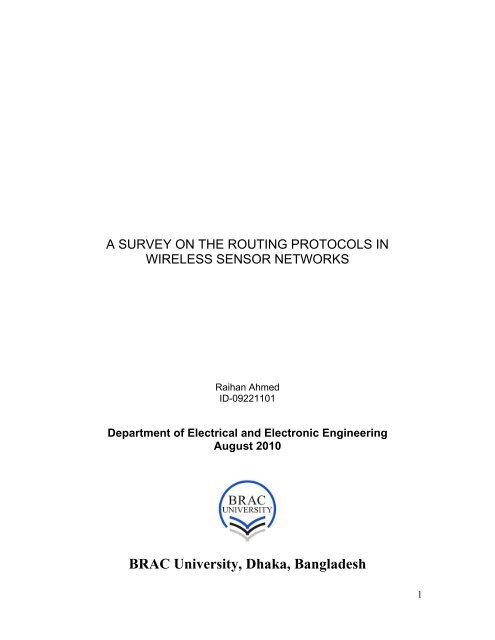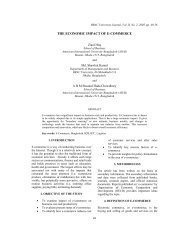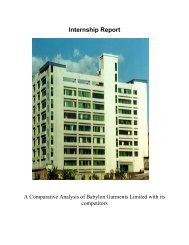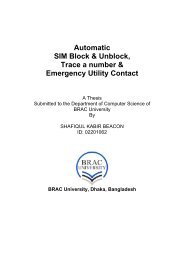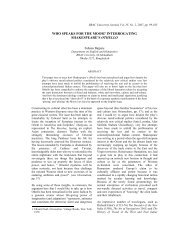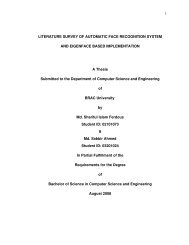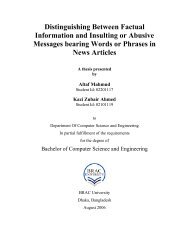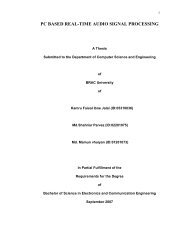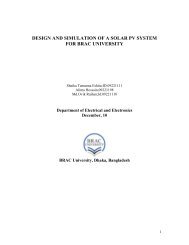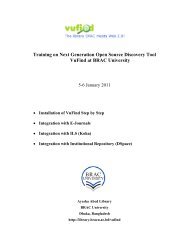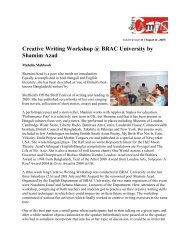Routing protocols in wireless sensor networks
Routing protocols in wireless sensor networks
Routing protocols in wireless sensor networks
You also want an ePaper? Increase the reach of your titles
YUMPU automatically turns print PDFs into web optimized ePapers that Google loves.
A SURVEY ON THE ROUTING PROTOCOLS IN<br />
WIRELESS SENSOR NETWORKS<br />
Raihan Ahmed<br />
ID-09221101<br />
Department of Electrical and Electronic Eng<strong>in</strong>eer<strong>in</strong>g<br />
August 2010<br />
BRAC University, Dhaka, Bangladesh<br />
1
DECLARATION<br />
I hereby declare that this thesis is based on the results found by myself.<br />
Materials of work found by other researcher are mentioned by reference. This<br />
thesis, neither <strong>in</strong> whole nor <strong>in</strong> part, has been previously submitted for any<br />
degree.<br />
Signature of Signature of<br />
Supervisor Author<br />
2
ACKNOWLEDGMENTS<br />
Special thanks to my supervisor Sadia Hamid Kazi who taught me how to<br />
th<strong>in</strong>k of random data clearly and logically, and for support<strong>in</strong>g this work <strong>in</strong> ways<br />
too numerous to list. Also the analysis of the data generated was only possible<br />
under her supervision. I thank her whole-heartedly for accept<strong>in</strong>g the difficult task<br />
of oversee<strong>in</strong>g this work to completion and for tak<strong>in</strong>g time out of her busy<br />
schedule to consider this work.<br />
3
ABSTRACT<br />
Recent advances <strong>in</strong> electronics and <strong>wireless</strong> communication technologies have<br />
enabled the development of large-scale <strong>wireless</strong> <strong>sensor</strong> <strong>networks</strong> that consist of<br />
many low-power, low-cost, and small-size <strong>sensor</strong> nodes. Sensor <strong>networks</strong> hold<br />
the promise of facilitat<strong>in</strong>g large-scale and real-time data process<strong>in</strong>g <strong>in</strong> complex<br />
environments.<br />
Some of the application areas are health, military, and home. In military, for<br />
example, the rapid deployment, self-organization, and fault tolerance<br />
characteristics of <strong>sensor</strong> <strong>networks</strong> make them a very promis<strong>in</strong>g technique for<br />
military command, control, communications, comput<strong>in</strong>g, and target<strong>in</strong>g systems.<br />
In health, <strong>sensor</strong> nodes can also be deployed to monitor patients and assist<br />
disabled patients, and etc.<br />
My area of <strong>in</strong>terest for the project is the survey of different rout<strong>in</strong>g <strong>protocols</strong> that<br />
have been developed for secure <strong>sensor</strong> <strong>networks</strong> and f<strong>in</strong>d their capabilities and<br />
deficiencies and suggest the most efficient among them.<br />
4
TABLE OF CONTENTS<br />
Page<br />
TITLE……………...........................................................................................…i<br />
DECLARATION….........................................................................................…ii<br />
ACKNOWLEDGEMENTS…………………………………………………………iii<br />
ABSTRACT………...........................................................................................iv<br />
TABLE OF CONTENTS...........................................................................…....v<br />
LIST OF TABLES............................................................................................vii<br />
LIST OF FIGURES........................................................................................viii<br />
CHAPTER I. INTRODUCTION<br />
1.1 WIRELESS SENSOR NETWORKS…………………………………....9<br />
1.2 COMPARISON OF MANETS AND SENSOR NETWORKS………...10<br />
1.3 APPLICATIONS OF WIRELESS SENSOR NETWORKS……….…..10<br />
1.4 ROUTING PROTOCOLS IN WIRELESS SENSOR NETWORKS….11<br />
CHAPTER II. WSN ROUTING PROTOCOLS<br />
2.1 INSENS ROUTING PROTOCOL………………………………………13<br />
2.2 TORA……………………………………………………………………...21<br />
2.3 LEACH……………………………………………………………….……24<br />
.<br />
CHAPTER III. METHODOLOGY<br />
3.1 LITERATURE REVIEW………………………………………….……...27<br />
3.2 SIMULATION AND ANALYSIS………………………………….…….27<br />
3.2.1 SIMULATION WITH NS-2 WITH MANNASIM…………….……….27<br />
3.2.2 ANALYSIS USING TRACE GRAPH OUTPUT…………….………28<br />
3.2.3 SIMULATION PARAMETERS…………………………………....…29<br />
3.2.4 PERFORMANCE METRICS…………………………………….......29<br />
3.2.5 SIMULATION METRICS………………………………………….….30<br />
CHAPTER IV. ANALYSIS AND SIMULATION RESULTS<br />
4.1 PACKET DELIVERY RATIO…………………………………………..31<br />
4.2 ROUTING LOAD……………………………………………………..…32<br />
5
4.3 AVERAGE END TO END DELAY………………………………….…33<br />
CHAPTER V. CONCLUSION……………………………………………….….35<br />
CHAPTER VI. FUTURE WORK………………………………………………..35<br />
REFERENCES…………………………………………………………………..36<br />
6
LIST OF TABLES<br />
Table Page<br />
3.2.3.1 Simulation Parameters…………………………………………………29<br />
3.2.5.1 Simulation metrics……………………………………………………...30<br />
4.1.1 Packet Delivery Ratio for WSN <strong>Rout<strong>in</strong>g</strong> Protocols……………….…31<br />
4.2.1 <strong>Rout<strong>in</strong>g</strong> Overhead for WSN <strong>Rout<strong>in</strong>g</strong> Protocols……………………...32<br />
4.3.1 Average End to End Delay for WSN <strong>Rout<strong>in</strong>g</strong> Protocols……………34<br />
7
LIST OF FIGURES<br />
Figure Page<br />
1.1a…….………………………………………………………………………….9<br />
1.4a………………………………………………………………………………..12<br />
2.1a………………………………………………………………………………..14<br />
2.1b………………………………………………………………………………..16<br />
2.1c………………………………………………………………………………..17<br />
2.1d………………………………………………………………………………..20<br />
2.2a………………………………………………………………………………..22<br />
2.3a………………………………………………………………………………..25<br />
2.3b………………………………………………………………………………..26<br />
4.1.2……………………………………………………………………………….31<br />
4.2.2……………………………………………………………………………….33<br />
4.3.2……………………………………………………………………………….34<br />
8
1.1 WIRELESS SENSOR NETWORKS<br />
1. INTRODUCTION<br />
A <strong>wireless</strong> <strong>sensor</strong> network (WSN) is a <strong>wireless</strong> network of many autonomous<br />
low-power, low-cost, and small-size <strong>sensor</strong> nodes that are self-organized and<br />
use <strong>sensor</strong>s to co-operatively monitor complex physical or environmental<br />
conditions, such as motion, temperature, sound etc. Such <strong>sensor</strong>s are generally<br />
equipped with data process<strong>in</strong>g and communication capabilities and are deployed<br />
<strong>in</strong> <strong>in</strong>door scenarios e.g.-the home and office, or outdoor scenarios like the<br />
natural, military and embedded environments. These nodes communicate with<br />
each other, shar<strong>in</strong>g data collected or other vital <strong>in</strong>formation to monitor a specific<br />
environment.<br />
A <strong>wireless</strong> <strong>sensor</strong> network is a network of many t<strong>in</strong>y disposable low power<br />
devices, called nodes, which are spatially distributed <strong>in</strong> order to perform an<br />
application-oriented global task. These nodes form a network by communicat<strong>in</strong>g<br />
with each other either directly or through other nodes. One or more nodes among<br />
them will serve as s<strong>in</strong>k(s) that are capable of communicat<strong>in</strong>g with the user either<br />
directly or through the exist<strong>in</strong>g wired <strong>networks</strong>. The primary component of the<br />
network is the <strong>sensor</strong>, essential for monitor<strong>in</strong>g real world physical conditions<br />
such as sound, temperature, humidity, <strong>in</strong>tensity, vibration, pressure, motion,<br />
pollutants etc. at different locations. The t<strong>in</strong>y <strong>sensor</strong> nodes, which consist of<br />
sens<strong>in</strong>g, on board processor for data process<strong>in</strong>g, and communicat<strong>in</strong>g<br />
components, leverage the idea of <strong>sensor</strong> <strong>networks</strong> based on collaborative effort<br />
of a large number of nodes [22].<br />
Fig 1.1a: Wireless Sensor Network Architecture [32]<br />
The ideal <strong>wireless</strong> <strong>sensor</strong> is networked and scalable, fault tolerance, consume<br />
very little power, smart and software programmable, efficient, capable of fast<br />
9
data acquisition, reliable and accurate over long term, cost little to purchase and<br />
required no real ma<strong>in</strong>tenance.[28]<br />
1.2 COMPARISON OF MANETS AND SENSOR NETWORKS<br />
MANETS (Mobile Ad-hoc Networks) and <strong>sensor</strong> <strong>networks</strong> are two classes of the<br />
<strong>wireless</strong> Ad-hoc <strong>networks</strong> with resource constra<strong>in</strong>ts. MANETS typically consist of<br />
devices that have high capabilities, mobile and operate <strong>in</strong> coalitions. Sensor<br />
<strong>networks</strong> are typically deployed <strong>in</strong> specific geographical regions for track<strong>in</strong>g,<br />
monitor<strong>in</strong>g and sens<strong>in</strong>g. Both these <strong>wireless</strong> <strong>networks</strong> are characterized by their<br />
ad hoc nature that lack pre deployed <strong>in</strong>frastructure for comput<strong>in</strong>g and<br />
communication. [28] Both share some characteristics like network topology is not<br />
fixed, power is an expensive resource and nodes <strong>in</strong> the network are connected to<br />
each other by <strong>wireless</strong> communication l<strong>in</strong>ks. WSNs differ <strong>in</strong> many fundamental<br />
ways from MANETS as mentioned below.<br />
• Sensor <strong>networks</strong> are ma<strong>in</strong>ly used to collect <strong>in</strong>formation while MANETS are<br />
designed for distributed comput<strong>in</strong>g rather than <strong>in</strong>formation gather<strong>in</strong>g.<br />
• Sensor nodes ma<strong>in</strong>ly use broadcast communication paradigm whereas<br />
most MANETS are based on po<strong>in</strong>t-to-po<strong>in</strong>t communications.<br />
• The number of nodes <strong>in</strong> <strong>sensor</strong> <strong>networks</strong> can be several orders of<br />
magnitude higher than that <strong>in</strong> MANETS.<br />
• Sensor nodes may not have global identification (ID) because of the large<br />
amount of overhead and large number of <strong>sensor</strong>s.<br />
• Sensor nodes are much cheaper than nodes <strong>in</strong> a MANET and are usually<br />
deployed <strong>in</strong> thousands.<br />
• Sensor nodes are limited <strong>in</strong> power, computational capacities, and memory<br />
where as nodes <strong>in</strong> a MANET can be recharged somehow.<br />
• Usually, <strong>sensor</strong>s are deployed once <strong>in</strong> their lifetime, while nodes <strong>in</strong><br />
MANET move really <strong>in</strong> an Ad-hoc manner.<br />
• Sensor nodes are much more limited <strong>in</strong> their computation and<br />
communication capabilities than their MANET counterparts due to their<br />
low cost.<br />
1.3 APPLICATIONS OF WIRELESS SENSOR NETWORKS<br />
Due to their attractive characteristics, WSNs can be deployed for different<br />
purposes <strong>in</strong> try<strong>in</strong>g environments. The scope of deployment which has been<br />
grow<strong>in</strong>g <strong>in</strong> the last decades covers many areas such as disaster management,<br />
border protection and combat field surveillance. Basically WSNs have the<br />
potential of be<strong>in</strong>g deployed any place where humans cannot easily access or<br />
there is danger to human life.<br />
Areas of probable usages of WSNs are<br />
• Military<br />
10
o Sens<strong>in</strong>g <strong>in</strong>truders on basis.<br />
o Detection of enemy unit movements on land and sea.<br />
o Battle field surveillances.<br />
• Emergency situations<br />
o Disaster management.<br />
o Fire/water detectors.<br />
o Hazardous chemical level and fires<br />
• Physical World<br />
o Environmental monitor<strong>in</strong>g of water and soil.<br />
o Habitual monitor<strong>in</strong>g.<br />
o Observation of biological and artificial systems.<br />
• Medical and Health<br />
o Sensors for blood flow, respiratory rate<br />
o ECG(electrocardiogram)<br />
• Industrial Factory process control and <strong>in</strong>dustrial automation [6].<br />
• Home Networks<br />
o Home appliances,<br />
o Location awareness.<br />
o Person locator<br />
1.4 ROUTING PROTOCOLS IN WIRELESS SENSOR NETWORKS:<br />
The communication between the nodes of a WSN must be governed by a set of<br />
rules (<strong>protocols</strong>) <strong>in</strong> order for them to function properly. And the data or<br />
<strong>in</strong>formation that they share amongst them can be tampered with by an outside<br />
<strong>in</strong>truder (adversary) for its own benefit jeopardiz<strong>in</strong>g the operations of the network.<br />
Thus the protocol used must provide confidentiality of the data shared among the<br />
<strong>sensor</strong> nodes <strong>in</strong> order to carry out an <strong>in</strong>tended operation <strong>in</strong> the selected<br />
environment successfully.<br />
Due to the difference of <strong>wireless</strong> <strong>sensor</strong> <strong>networks</strong> from other contemporary<br />
communication and <strong>wireless</strong> ad hoc <strong>networks</strong> rout<strong>in</strong>g is a very challeng<strong>in</strong>g task <strong>in</strong><br />
WSNs. For the deployed sheer number of <strong>sensor</strong> nodes it is impractical to build a<br />
global scheme for them. IP-based <strong>protocols</strong> cannot be applied to these <strong>networks</strong>.<br />
All applications of <strong>sensor</strong> <strong>networks</strong> have the requirement of send<strong>in</strong>g the sensed<br />
data from multiple po<strong>in</strong>ts to a common dest<strong>in</strong>ation called s<strong>in</strong>k. Resource<br />
management is required <strong>in</strong> <strong>sensor</strong> nodes regard<strong>in</strong>g transmission power, storage,<br />
on-board energy and process<strong>in</strong>g capacity.<br />
There are various rout<strong>in</strong>g <strong>protocols</strong> that have been proposed for rout<strong>in</strong>g data <strong>in</strong><br />
<strong>wireless</strong> <strong>sensor</strong> <strong>networks</strong> due to such problems. The proposed mechanisms of<br />
rout<strong>in</strong>g consider the architecture and application requirements along with the<br />
characteristics of <strong>sensor</strong> nodes.<br />
There are few dist<strong>in</strong>ct rout<strong>in</strong>g <strong>protocols</strong> that are based on quality of service<br />
awareness or network flow whereas all other rout<strong>in</strong>g <strong>protocols</strong> can be classified<br />
as hierarchical or location based and data centric.<br />
11
Presently quite a lot of WSN <strong>protocols</strong> are available us<strong>in</strong>g different techniques<br />
to ensure proper rout<strong>in</strong>g of authentic data; each protocol has its own advantages<br />
and disadvantages <strong>in</strong> design.<br />
The figure below shows the different network architectures and rout<strong>in</strong>g<br />
techniques used by the <strong>protocols</strong> to work.<br />
Fig 1.4a: <strong>Rout<strong>in</strong>g</strong> <strong>protocols</strong> <strong>in</strong> WSNs.<br />
The figure shows three different network structures:<br />
Flat rout<strong>in</strong>g:<br />
Each <strong>sensor</strong> nodes behaves the same way and co-operates with other nodes to<br />
perform the sens<strong>in</strong>g task. The network conta<strong>in</strong>s a large number of such nodes<br />
and a Base Station (BS) sends queries to certa<strong>in</strong> regions and waits for data from<br />
the <strong>sensor</strong>s located <strong>in</strong> the selected regions. Data-centric rout<strong>in</strong>g is used where<br />
there is no global identifier for nodes; <strong>in</strong>stead data is identified us<strong>in</strong>g attribute<br />
based nam<strong>in</strong>g.<br />
Hierarchical <strong>Rout<strong>in</strong>g</strong>:<br />
This rout<strong>in</strong>g method have special advantages related to scalability and efficient<br />
communication, they also provide energy-efficient rout<strong>in</strong>g <strong>in</strong> WSNs.<br />
Location-Based <strong>Rout<strong>in</strong>g</strong>:<br />
Sensor nodes are addressed depend<strong>in</strong>g on their locations. Relative coord<strong>in</strong>ates<br />
of neighbor<strong>in</strong>g nodes is obta<strong>in</strong>ed either by exchang<strong>in</strong>g <strong>in</strong>formation between<br />
neighbor nodes or by directly communicat<strong>in</strong>g with a Global Position<strong>in</strong>g System<br />
(GPS). [8]<br />
12
The figure also gives an overview of the different rout<strong>in</strong>g techniques employed by<br />
the <strong>protocols</strong> to work. This literature <strong>in</strong>tends to survey three <strong>protocols</strong>, INSENS<br />
(Hierarchical <strong>Rout<strong>in</strong>g</strong>), TORA (Flat rout<strong>in</strong>g), and LEACH (Hierarchical <strong>Rout<strong>in</strong>g</strong>),<br />
discover<strong>in</strong>g their capabilities and deficiencies and suggest<strong>in</strong>g the most efficient<br />
among them.<br />
2.1 INSENS ROUTING PROTOCOL:<br />
2. WSN ROUTING PROTOCOLS<br />
INSENS operates by tolerat<strong>in</strong>g <strong>in</strong>trusions by bypass<strong>in</strong>g the malicious nodes<br />
rather than rely<strong>in</strong>g on traditional <strong>in</strong>trusion-detection techniques to detect them.<br />
The idea is that even if a well-equipped <strong>in</strong>truder can compromise <strong>in</strong>dividual<br />
<strong>sensor</strong> nodes, these <strong>in</strong>trusions can be tolerated and the network as a whole<br />
would rema<strong>in</strong> function<strong>in</strong>g despite such localized <strong>in</strong>trusions so that the overall<br />
design of the WSN would rema<strong>in</strong> secure. The paths are designed so that even if<br />
an <strong>in</strong>truder takes down a s<strong>in</strong>gle node or path, <strong>in</strong>dependent secondary paths will<br />
exist to forward the packet to the correct dest<strong>in</strong>ation. While a malicious node may<br />
be able to compromise a small number of nodes <strong>in</strong> its vic<strong>in</strong>ity, it cannot cause<br />
widespread damage <strong>in</strong> the network. INSENS operates by hav<strong>in</strong>g a base station<br />
possess more resources <strong>in</strong> terms of power, computation, memory, and<br />
bandwidth than the <strong>in</strong>dividual <strong>sensor</strong> nodes. This m<strong>in</strong>imizes computation,<br />
communication, storage, and bandwidth requirements at the <strong>sensor</strong> nodes at the<br />
expense of <strong>in</strong>creased computation, communication, storage, and bandwidth<br />
requirements at the base station. [1]<br />
Each message sent from a source to a dest<strong>in</strong>ation is sent multiple times, once<br />
along each redundant path. One or more <strong>in</strong>truders along some of these paths<br />
can threaten the delivery or tamper of some of the copies of a message.<br />
However, as long as there is at least one path that is not affected by an <strong>in</strong>truder,<br />
the dest<strong>in</strong>ation will receive at least one copy of the message that has not been<br />
tampered with so this approach works despite the presence of (undetected)<br />
<strong>in</strong>truders.<br />
INSENS's design is based on three pr<strong>in</strong>ciples:<br />
(i) Utilize redundancy to tolerate <strong>in</strong>trusions without any need for detect<strong>in</strong>g the<br />
node(s) where <strong>in</strong>trusions have occurred and operate properly even <strong>in</strong> the<br />
presence of (undetected) <strong>in</strong>truders.<br />
13
(ii)Shift the entire computational load i.e. build<strong>in</strong>g rout<strong>in</strong>g tables, or deal<strong>in</strong>g with<br />
security and <strong>in</strong>trusion-tolerance issues from the <strong>in</strong>dividual <strong>sensor</strong> nodes to the<br />
base station thus m<strong>in</strong>imiz<strong>in</strong>g computation, storage, and bandwidth requirements<br />
at the <strong>sensor</strong> nodes.<br />
(iii) Limit the scope of damage done by (undetected) <strong>in</strong>truders by limit<strong>in</strong>g flood<strong>in</strong>g<br />
and us<strong>in</strong>g appropriate authentication mechanisms. INSENS uses symmetric-key<br />
cryptography to implement these mechanisms. [1]<br />
To prevent DOS-style flood<strong>in</strong>g attacks <strong>in</strong>dividual nodes are not allowed<br />
broadcast<strong>in</strong>g to the entire network, only the base station is allowed to broadcast.<br />
INSENS constructs network rout<strong>in</strong>g for an asymmetric or hierarchical architecture<br />
consist<strong>in</strong>g of a base station and <strong>sensor</strong>s, unlike a peer-based rout<strong>in</strong>g<br />
architecture. As a result, INSENS's protocol and security architecture are far<br />
different. In INSENS, each node shares a secret key only with the base station,<br />
and not with any other nodes. The advantage is <strong>in</strong> case a node is compromised<br />
that an <strong>in</strong>truder will only have access to one secret key, rather than the secret<br />
keys of neighbors and/or other nodes throughout the network.<br />
Fig 2.1a: Sample asymmetric WSN topology over 10 <strong>sensor</strong> nodes with multiple<br />
paths to the base station.<br />
Moreover, sett<strong>in</strong>g up keys is simple <strong>in</strong> INSENS; each node needs only one secret<br />
key for authenticat<strong>in</strong>g itself to the base station, and one <strong>in</strong>itial key for<br />
authenticat<strong>in</strong>g the base station to each node. Tamper detection ensures that the<br />
base station is able to glean out the correct (untampered) <strong>in</strong>formation from all the<br />
messages it receives from <strong>sensor</strong> nodes.<br />
INSENS employs the one-way authentication mechanism to authenticate any<br />
<strong>in</strong>formation sent by the base station, and appropriate <strong>in</strong>tegrity mechanisms to<br />
14
ensure that any tamper<strong>in</strong>g with the <strong>in</strong>formation be<strong>in</strong>g exchanged can be detected<br />
by the <strong>in</strong>tended receiver. In addition, INSENS limits flood<strong>in</strong>g of messages by<br />
allow<strong>in</strong>g communication only between the base station and the <strong>sensor</strong> nodes,<br />
and by hav<strong>in</strong>g <strong>sensor</strong> nodes drop duplicate messages.<br />
Route Discovery:<br />
The base station <strong>in</strong>itiates the first round whenever it needs to construct the<br />
forward<strong>in</strong>g tables of all <strong>sensor</strong> nodes. This is usually <strong>in</strong> the beg<strong>in</strong>n<strong>in</strong>g when the<br />
network is just established, or when the network may have changed substantially<br />
due to node mobility. The base station broadcasts a request message that all the<br />
<strong>sensor</strong> nodes receive, each <strong>sensor</strong> node that receives the request message for<br />
the first time <strong>in</strong> turn broadcasts a request message. This message broadcasted<br />
by the <strong>sensor</strong> node <strong>in</strong>cludes a path from the base station to the particular node.<br />
When a node receives a request message for the first time, it forwards<br />
(broadcasts) this message after append<strong>in</strong>g its identity <strong>in</strong> the path, it also records<br />
the identity of the sender of this message <strong>in</strong> its neighbour set. If a node receives<br />
duplicate request messages, the identity of the sender is added to its neighbour<br />
set, but the duplicate request is not rebroadcast.<br />
This serves three purposes: (1) it <strong>in</strong>forms all <strong>sensor</strong> nodes that the base station<br />
is collect<strong>in</strong>g topology <strong>in</strong>formation to build forward<strong>in</strong>g tables, (2) it aids <strong>in</strong><br />
construct<strong>in</strong>g a path from each <strong>sensor</strong> node to the base station that is used <strong>in</strong> the<br />
second round to forward feedback messages to the base station, and (3) a node<br />
receiv<strong>in</strong>g a request message learns that the sender of that message is its<br />
neighbour. [1]<br />
An adversary <strong>in</strong> the network can attempt to launch several attacks <strong>in</strong> this round.<br />
First, it can attempt to deceive the base station by send<strong>in</strong>g a spurious request<br />
message. Second, it can <strong>in</strong>clude a fake path <strong>in</strong> the request message it forwards.<br />
Third, it may not forward a request message, or launch a DOS attack by<br />
repeatedly send<strong>in</strong>g several request messages. These attacks are counter-acted<br />
by two mechanisms:<br />
First, we leverage the concept of one-way sequences proposed by the μTESLA<br />
protocol [Perrig01] to identify a request message <strong>in</strong>itiated by the base station and<br />
to restrict DOS-style flood<strong>in</strong>g attacks. The base station generates a sequence of<br />
numbers n1 , n2 , n3 ,..., nk-1, nk, such that ni+1 = F( ni ) , where F is a one-way<br />
function, 0 < i < k , and n1 is chosen randomly. F is such that it is computationally<br />
impossible to compute nk-1 <strong>in</strong> a limited time by know<strong>in</strong>g nk and F. All <strong>sensor</strong><br />
nodes are pre-configured with function F and value nk.<br />
15
Fig 2.1b: Route request format<br />
The base station transmits nk-1 (called a One-Way Sequence (OWS) number) <strong>in</strong><br />
the first request messages shown <strong>in</strong> Fig 2.1b. If the base station needs to<br />
construct forward<strong>in</strong>g tables aga<strong>in</strong>, the second request message transmitted by<br />
the base station will be assigned an OWS2=nk-2. The i'th request message will be<br />
assigned OWSi=nk-i. All nodes forward<strong>in</strong>g the i'th request message repeat OWSi<br />
<strong>in</strong> the header. A <strong>sensor</strong> node which receives the i'th request message will<br />
compute F j (OWSi) for j=1,2,…,J, where F j (#) = F(F(...F(#)) applied j times. A<br />
<strong>sensor</strong> node will be hav<strong>in</strong>g the most up to date OWSfresh that it has received from<br />
the base station. If OWSfresh is with<strong>in</strong> J applications of the function F to OWSi<br />
from the i'th request message, then F j (OWSi) = OWSfresh for some j. This match<br />
enables the <strong>sensor</strong> node to verify that the OWS has been generated only by the<br />
base station. If they don’t match, then the packet is identified spurious and is<br />
dropped. This policy prevents propagation of spurious messages. Also,<br />
messages whose OWS is older than OWSfresh are not forwarded. This policy<br />
prevents a node from flood<strong>in</strong>g the network with out of date messages. For<br />
example, when a <strong>sensor</strong> node receives the first request message, it will compare<br />
F(OWS1) with OWSfresh = nk. If there is a match, then the node knows that only<br />
the base station could have produced this next OWS <strong>in</strong> the sequence. Otherwise,<br />
the message is deemed spurious and is not forwarded. [1]<br />
An <strong>in</strong>fected node cannot generate the next OWS number <strong>in</strong> the sequence and so<br />
cannot spoof the base station. But it’s possible that a malicious node could flood<br />
a modified request message us<strong>in</strong>g the current OWS from a valid request<br />
message just transmitted by the base station, this is known as a rush<strong>in</strong>g attack.<br />
The adversary tries to transmit a spurious message before the base station can<br />
propagate its own valid message. The <strong>in</strong>truder first waits to hear the current<br />
OWS from the base station and then launches its own attack. The nodes <strong>in</strong> the<br />
tree those are closer to the base station than the malicious nodes receive the<br />
valid request messages first as same OWS are not rebroadcast, these nodes<br />
then drop the <strong>in</strong>truder’s spurious request messages received later. And s<strong>in</strong>ce the<br />
nodes forward only one request message per OWS, an attacker can send a<br />
request message no more than once i.e. a DOS attack is <strong>in</strong>feasible by the<br />
<strong>in</strong>truder. Even if the sends a request message with a long fake path, the damage<br />
16
is limited to the nodes nearest to and downstream from the <strong>in</strong>truder, the rest of<br />
the network can be considered to be not <strong>in</strong>fected.<br />
In the second mechanism each node is configured with a separate secret key<br />
that is shared with the base station. A node generates a 16-byte MAC Request<br />
(MACRx) by apply<strong>in</strong>g a keyed MAC algorithm before send<strong>in</strong>g a request<br />
message. This MAC is applied to the complete path consist<strong>in</strong>g of the current<br />
node’s identity appended to the path from the <strong>in</strong>com<strong>in</strong>g request message.<br />
The secret key of the node is used to generate the follow<strong>in</strong>g MACR:<br />
MACRx =MAC ( size | path |OWS | type, Keyx )<br />
where "|" denotes concatenation. This MACR <strong>in</strong> the request message is used to<br />
check the <strong>in</strong>tegrity of the path <strong>in</strong> the second round when the nodes receiv<strong>in</strong>g the<br />
request message need to forward a feedback message to the base station along<br />
this path (<strong>in</strong> the reverse direction). A malicious node forward<strong>in</strong>g a feedback<br />
message towards the base station with a fake path will not have the correct MAC<br />
and as a result the spurious message will be dropped.<br />
So, even if a malicious node escapes detection <strong>in</strong> the first round it will be<br />
detected <strong>in</strong> the second round.<br />
In the second round each <strong>sensor</strong> node sends a feedback message back to the<br />
base station which conta<strong>in</strong>s a set of identities of its neighbor nodes as well as the<br />
path to itself from the base station. Before generat<strong>in</strong>g a feedback message a<br />
node waits for a certa<strong>in</strong> timeout <strong>in</strong>terval so that a node can listen to its<br />
neighbours (upstream, peer and downstream) forward<strong>in</strong>g the same request<br />
message.<br />
Fig 2.1c: Route feedback message from node x<br />
17
The figure above (Fig 2.1c) shows a feedback packet, nbr_<strong>in</strong>fo denotes the<br />
identities of all its neighbours, path_<strong>in</strong>fo denotes the path to that node from the<br />
base station. For example, if node x receives the first request message for the<br />
current OWS from neighbor c, then neighbor c becomes the parent of neighbor x,<br />
namely px=c. If this first request message from c conta<strong>in</strong>ed the path base->a->b-<br />
>c, then the path returned <strong>in</strong> node x's path_<strong>in</strong>fo will be base->a->b->c->x.<br />
The MACF ensures that the base station will construct a correct topology, though<br />
it may be <strong>in</strong>complete due to malicious nodes. The follow<strong>in</strong>g keyed<br />
MACFeedbackx ma<strong>in</strong>ta<strong>in</strong>s the <strong>in</strong>tegrity of the packet and packets reach<strong>in</strong>g the<br />
base station are guaranteed after verification to be correct and secure from<br />
tamper<strong>in</strong>g. The nbr_<strong>in</strong>fo serves to double-check aga<strong>in</strong>st any possible tampered<br />
packets which may have somehow dodged <strong>in</strong>spection. By now, each child node<br />
will have already identified its parent as the first of its upstream neighbors to<br />
send the child a request message with the current OWS. [2]<br />
The l<strong>in</strong>ked cha<strong>in</strong> of child-parent pairs creates a reverse unicast path from node x<br />
back to the base station (multiple paths are not available until after round three).<br />
Before forward<strong>in</strong>g a feedback message, a child node should place parent<br />
identification <strong>in</strong>formation <strong>in</strong>to the parent_<strong>in</strong>fo field of the feedback message. This<br />
parent_<strong>in</strong>fo determ<strong>in</strong>es which of a child's upstream neighbours is the parent who<br />
should forward the feedback message. A child node places its parent’s MACRp<br />
<strong>in</strong>to the parent_<strong>in</strong>fo field which it already has from the first request message it<br />
received from the parent dur<strong>in</strong>g the first round. The MACRp has a correspond<strong>in</strong>g<br />
OWS which serves as a security function as well as an address<strong>in</strong>g function. This<br />
means that spurious message cannot be forwarded as a valid address of any<br />
upstream node (required for the message to be accepted by the upstream node)<br />
isn’t available even if the attacker may have the node ID’s. An upstream node<br />
only forwards packets whose MACR matches its own MACR (selected as the<br />
child’s parent) <strong>in</strong> accordance with the OWS, otherwise the packet is dropped.<br />
An orig<strong>in</strong>at<strong>in</strong>g node only generates the MACF and <strong>in</strong>termediate nodes use the<br />
one-way function F to verify an OWS that they don’t recognize, otherwise these<br />
nodes need not recalculate a MAC and simply engage <strong>in</strong> logic comparisons of<br />
MACR's as well as memory copies of the new MACRp <strong>in</strong>to the parent_<strong>in</strong>fo field.<br />
Only the parent_<strong>in</strong>fo field is modified as the message is propagated back, the<br />
path_<strong>in</strong>fo and nbr_<strong>in</strong>fo <strong>in</strong> the feedback message rema<strong>in</strong> unchanged.<br />
To combat the memory exhaustion attacks the nodes store only 1 bit per node to<br />
flag whether an orig<strong>in</strong>at<strong>in</strong>g ID has been seen before; a malicious node will not be<br />
able to overflow this fixed and compact memory allocation. Hash<strong>in</strong>g may reduce<br />
this memory requirement but some feedback messages may be missed that<br />
hash to the same value.<br />
18
A second mechanism to counter-attack DOS attacks is done us<strong>in</strong>g rate control;<br />
thousands of phantom nodes may send feedback messages by tak<strong>in</strong>g advantage<br />
of the fact that <strong>in</strong> the second round nodes can <strong>in</strong> fact forward many feedback<br />
messages. Malicious nodes can send messages hav<strong>in</strong>g a valid OWS number,<br />
any orig<strong>in</strong>at<strong>in</strong>g ID, and a valid MACRp of any upstream node. An upstream node<br />
(except the base station) has no way of dist<strong>in</strong>guish<strong>in</strong>g between an authentic<br />
feedback message and a spurious feedback message <strong>in</strong> this type of attacks. So<br />
even if malicious nodes send messages at a very fast rate, the upstream<br />
(correct) nodes will forward those messages only at a slower (legitimate) rate,<br />
thus prevent<strong>in</strong>g congestion on all the further upstream nodes.<br />
To ma<strong>in</strong>ta<strong>in</strong> confidentiality aga<strong>in</strong>st eavesdropp<strong>in</strong>g by a malicious node, the<br />
path_<strong>in</strong>fo (the identity field of the orig<strong>in</strong>at<strong>in</strong>g node <strong>in</strong> path_<strong>in</strong>fo is left<br />
unencrypted) and nbr_<strong>in</strong>fo is encrypted us<strong>in</strong>g the orig<strong>in</strong>at<strong>in</strong>g node x's secret key.<br />
Only the Type, OWS, parent_<strong>in</strong>fo MACRp, and identity of the orig<strong>in</strong>at<strong>in</strong>g node or<br />
sender are left unencrypted. So no topology <strong>in</strong>formation is revealed among the<br />
nodes but the identity of the orig<strong>in</strong>at<strong>in</strong>g node must be unencrypted so that the<br />
base station can determ<strong>in</strong>e to whom the topology <strong>in</strong>formation <strong>in</strong> the feedback<br />
packet belongs, and so that duplicate feedback packets can be spotted.<br />
In attacks where an <strong>in</strong>truder substitutes the MACR of any of its non-parental<br />
upstream nodes which divert packets away from its one valid parent INSENS’s<br />
pr<strong>in</strong>ciple allows feedback packets to simply follow another path of l<strong>in</strong>ked childparent<br />
pairs that lead back to the base station. Moreover the broadcast nature of<br />
the <strong>wireless</strong> medium other upstream nodes will hear this feedback message and<br />
drop any duplicates. Therefore spurious messages cannot be forwarded by<br />
malicious child nodes towards the upstream neighbours.<br />
In the third round the base station receives all the authentic feedback messages<br />
and recomputes the MACFx and checks if there is a match. If there is a match,<br />
then the base station attempts to match the nodes listed as neighbors with prior<br />
<strong>in</strong>formation received by the base station. The MACR's <strong>in</strong> nbr_<strong>in</strong>fo received from<br />
neighbors should be consistent with the MACR's reported back to the base<br />
station; this proves that the nodes have heard each other’s <strong>in</strong>dividual rebroadcast<br />
which clears them of any phantom nodes. The base station now computes the<br />
forward<strong>in</strong>g tables for each node <strong>in</strong> the network. S<strong>in</strong>ce the base station has the<br />
complete <strong>in</strong>formation about the network it can perform better <strong>in</strong> select<strong>in</strong>g<br />
appropriate routes <strong>in</strong> terms of balanc<strong>in</strong>g the rout<strong>in</strong>g load on the <strong>sensor</strong> nodes<br />
and us<strong>in</strong>g appropriate algorithms to select redundant routes that m<strong>in</strong>imize the<br />
extent of damage a malicious node may cause. The first path selection is done<br />
us<strong>in</strong>g Dijkstra’s shortest path algorithm and the second path is kept at the edge<br />
from the neighbours of the neighbours of the first path, if no path is found <strong>in</strong> this<br />
step the neighbours of the neighbours of the first path are <strong>in</strong>cluded and a path is<br />
calculated from them. Aga<strong>in</strong>, if no path is found neighbours of the first path are<br />
also <strong>in</strong>cluded and the path calculated from them. There could be cases where a<br />
second path is not found, so then INSENS ma<strong>in</strong>ta<strong>in</strong>s only a s<strong>in</strong>gle path.<br />
19
After comput<strong>in</strong>g the redundant paths and the forward<strong>in</strong>g tables for each node the<br />
base station forwards the forward<strong>in</strong>g tables to the respective nodes. The base<br />
station sends the tables to the nodes nearest to it and then proceeds further<br />
outwards; the redundant rout<strong>in</strong>g mechanism is used <strong>in</strong> this case with standard<br />
security measures.<br />
Fig 2.1d: <strong>Rout<strong>in</strong>g</strong> table update message<br />
The above figure (Fig 2.1d) shows the format of the rout<strong>in</strong>g table message used<br />
to propagate the forward<strong>in</strong>g tables. Dest conta<strong>in</strong>s the address ID of the<br />
dest<strong>in</strong>ation node x. Size conta<strong>in</strong>s the length of the message, and forward<strong>in</strong>g<br />
table conta<strong>in</strong>s the forward<strong>in</strong>g table for node x. The forward<strong>in</strong>g table entry is<br />
encrypted us<strong>in</strong>g the secret key of x. The MAC conta<strong>in</strong>s the MAC of the complete<br />
message generated us<strong>in</strong>g the secret key of x.<br />
A node ma<strong>in</strong>ta<strong>in</strong>s a forward<strong>in</strong>g table that has several entries, one for each route<br />
to which the node belongs. Each entry is a 3-tuple: dest<strong>in</strong>ation, source, and<br />
immediate sender. Dest<strong>in</strong>ation is the node id of the dest<strong>in</strong>ation node to which a<br />
data packet is sent, source is the node id of the node that created this data<br />
packet, and immediate sender is the node id of the node that just forwarded this<br />
packet. For example, given a route from node S to D: S->a->b->c->D, the<br />
forward<strong>in</strong>g table of node a will conta<strong>in</strong> an entry , forward<strong>in</strong>g table of b<br />
will conta<strong>in</strong> an entry , and the forward<strong>in</strong>g table of c will conta<strong>in</strong> an entry<br />
. The node id of the immediate sender is used because a node may<br />
receive a packet with the same source and dest<strong>in</strong>ation node many times,<br />
because each packet is forwarded over multiple routes. For example, if the other<br />
route from S to D is S->e->f->g->h->D, and b and h are neighbors, b will receive<br />
the data packet forwarded by h, which it should not forward. This is accomplished<br />
by <strong>in</strong>clud<strong>in</strong>g the immediate sender field.<br />
When the protocol INSENS is compared with a protocol hav<strong>in</strong>g no security or<br />
<strong>in</strong>trusion tolerance, it is found that INSENS sends more packets with <strong>in</strong>creas<strong>in</strong>g<br />
number of nodes; this is due to the security and <strong>in</strong>trusion-tolerance issues. It is<br />
also observed that active attacks do more damage than passive attacks due to<br />
malicious nodes dur<strong>in</strong>g route discovery. INSENS reduces the number of nodes<br />
that can be blocked over a s<strong>in</strong>gle path rout<strong>in</strong>g protocol.<br />
Poor performance were obta<strong>in</strong>ed when the network is less dense that is nodes<br />
have fewer neighbours consequently few alternative paths. But the protocol does<br />
perform <strong>in</strong>creas<strong>in</strong>gly well for denser <strong>networks</strong>.<br />
20
2.2 TORA<br />
The TORA uses a "flat", non-hierarchical rout<strong>in</strong>g algorithm to achieve a high<br />
degree of scalability. TORA is an on-demand rout<strong>in</strong>g protocol. The ma<strong>in</strong><br />
objective of TORA is to limit control message propagation <strong>in</strong> the highly dynamic<br />
mobile comput<strong>in</strong>g environment. Control messages are localized to a very small<br />
set of nodes and it provides multiple routes for a dest<strong>in</strong>ation. Each node has to<br />
explicitly <strong>in</strong>itiate a query when it needs to send data to a particular dest<strong>in</strong>ation.<br />
The protocol performs three basic functions:<br />
• Route creation<br />
• Route ma<strong>in</strong>tenance<br />
• Route erasure<br />
Dur<strong>in</strong>g the route creation and ma<strong>in</strong>tenance phases, nodes use a “height” metric<br />
to establish a directed acyclic graph (DAG) rooted at the dest<strong>in</strong>ation. Thereafter,<br />
l<strong>in</strong>ks are assigned a direction (upstream or downstream) based on the relative<br />
height metric of neighbor<strong>in</strong>g nodes, as shown <strong>in</strong> Fig. 5a. Routes are ma<strong>in</strong>ta<strong>in</strong>ed<br />
by re-establish<strong>in</strong>g routes to dest<strong>in</strong>ation <strong>in</strong> response to topological changes. In<br />
times of node mobility the DAG route is broken, and route ma<strong>in</strong>tenance is<br />
necessary to re-establish a DAG rooted at the same dest<strong>in</strong>ation.<br />
21
Fig 2.2a: a) Route creation (show<strong>in</strong>g l<strong>in</strong>k direction assignment); b) route<br />
ma<strong>in</strong>tenance (show<strong>in</strong>g the l<strong>in</strong>k reversal phenomenon) <strong>in</strong> TORA.<br />
As shown <strong>in</strong> Fig. 2.2a(b), upon failure of the last downstream l<strong>in</strong>k, a node<br />
generates a new reference level which results <strong>in</strong> the propagation of that<br />
reference level by neighbor<strong>in</strong>g nodes, effectively coord<strong>in</strong>at<strong>in</strong>g a structured<br />
reaction to the failure. L<strong>in</strong>ks are reversed to reflect the change <strong>in</strong> adapt<strong>in</strong>g to the<br />
new reference level. This has the same effect as revers<strong>in</strong>g the direction of one or<br />
more l<strong>in</strong>ks when a node has no downstream l<strong>in</strong>ks. Tim<strong>in</strong>g is an important factor<br />
for TORA because the “height” metric is dependent on the logical time of a l<strong>in</strong>k<br />
failure; TORA assumes that all nodes have synchronized clocks (accomplished<br />
via an external time source such as the Global Position<strong>in</strong>g System). TORA’s<br />
metric is a qu<strong>in</strong>tuple compris<strong>in</strong>g five elements, namely:<br />
• Logical time of a l<strong>in</strong>k failure<br />
• The unique ID of the node that def<strong>in</strong>ed the new reference level<br />
• A reflection <strong>in</strong>dicator bit<br />
• A propagation order<strong>in</strong>g parameter<br />
• The unique ID of the node<br />
22
The first three elements collectively represent the reference level. A new<br />
reference level is def<strong>in</strong>ed each time a node loses its last downstream l<strong>in</strong>k due to<br />
a l<strong>in</strong>k failure. TORA’s route erasure phase essentially <strong>in</strong>volves flood<strong>in</strong>g a<br />
broadcast clear packet (CLR) throughout the network to erase <strong>in</strong>valid routes.<br />
In TORA there is a potential for oscillations to occur, especially when multiple<br />
sets of coord<strong>in</strong>at<strong>in</strong>g nodes are concurrently detect<strong>in</strong>g partitions, eras<strong>in</strong>g routes,<br />
and build<strong>in</strong>g new routes based on each other. Because TORA uses <strong>in</strong>ternodal<br />
co-ord<strong>in</strong>ation, its <strong>in</strong>stability problem is similar to the “count-to-<strong>in</strong>f<strong>in</strong>ity” problem <strong>in</strong><br />
distance-vector rout<strong>in</strong>g <strong>protocols</strong>, except that such oscillations.<br />
Upon the detection of a network partition, all l<strong>in</strong>ks must be undirected to erase<br />
<strong>in</strong>valid routes and the control packets: query (QRY), update (UPD), and clear<br />
(CLR) are used to accomplish these tasks. QRY packets are used for creat<strong>in</strong>g<br />
routes, UPD packets are used for both creat<strong>in</strong>g and ma<strong>in</strong>ta<strong>in</strong><strong>in</strong>g routes, and CLR<br />
packets are used for eras<strong>in</strong>g routes. [20]<br />
A node receiv<strong>in</strong>g a QRY packet does one of the follow<strong>in</strong>g:<br />
• if its route required flag is set, this means that it doesn't have to forward<br />
the QRY, because it itself has already issued a QRY for the dest<strong>in</strong>ation,<br />
but better discard it to prevent message overhead.<br />
• if the node has no downstream l<strong>in</strong>ks and the route-required flag was not<br />
set, it sets its route-required flag and rebroadcasts the QRY message.<br />
• if a node has at least one downstream neighbour and the height for that<br />
l<strong>in</strong>k is null it sets its height to the m<strong>in</strong>imum of the heights of the neighbour<br />
nodes, <strong>in</strong>crements its d value by one and broadcasts an UPD packet.<br />
• if the node has a downstream l<strong>in</strong>k and its height is non-NULL it discards<br />
the QRY packet if an UPD packet was be<strong>in</strong>g issued s<strong>in</strong>ce the l<strong>in</strong>k became<br />
active (rr-Flag set). Otherwise it sends an UPD packet.<br />
A node receiv<strong>in</strong>g an update packet updates the height value of its neighbour <strong>in</strong><br />
the table and takes one of the follow<strong>in</strong>g actions:<br />
• if the reflection bit of the neighbours height is not set and its route required<br />
flag is set it sets its height for the dest<strong>in</strong>ation to that of its neighbours but<br />
<strong>in</strong>crements d by one. It then deletes the RR flag and sends an UPD<br />
message to the neighbours, so they may route through it.<br />
• if the neighbour’s route is not valid (which is <strong>in</strong>dicated by the reflection bit)<br />
or the RR flag was unset, the node only updates the entry of the<br />
neighbour’s node <strong>in</strong> its table. [24]<br />
TORA is a “l<strong>in</strong>k reversal” algorithm that is best suited for <strong>networks</strong> with large<br />
dense populations of nodes. Part of the novelty of TORA stems from its creation<br />
of DAGs to aid route establishment. One of the advantages of TORA is its<br />
support for multiple routes. Route reconstruction is not necessary until all known<br />
23
outes to a dest<strong>in</strong>ation are deemed <strong>in</strong>valid, and hence bandwidth can potentially<br />
be conserved because of the necessity for fewer route rebuild<strong>in</strong>g. However, route<br />
rebuild<strong>in</strong>g <strong>in</strong> TORA may not occur as quickly as <strong>in</strong> the other algorithms due to the<br />
potential for oscillations dur<strong>in</strong>g this period. This can lead to potentially lengthy<br />
delays while wait<strong>in</strong>g for the new routes to be determ<strong>in</strong>ed.<br />
2.3 LEACH<br />
LEACH is based on a hierarchical cluster<strong>in</strong>g structure model and energy efficient<br />
cluster-based rout<strong>in</strong>g <strong>protocols</strong> for <strong>sensor</strong> <strong>networks</strong>. In this rout<strong>in</strong>g protocol,<br />
nodes self-organize themselves <strong>in</strong>to several local clusters, each of which has<br />
one node serv<strong>in</strong>g as the cluster-head. In order to prolong the overall lifetime of<br />
the <strong>sensor</strong> <strong>networks</strong>, LEACH changes cluster heads periodically. LEACH has<br />
two ma<strong>in</strong> steps: the set-up phase and the steady-state phase. In the set-up<br />
phase, there are two parts, the cluster-head elect<strong>in</strong>g part and the cluster<br />
construct<strong>in</strong>g part. After the cluster-heads have been decided on, <strong>sensor</strong> nodes<br />
(which are chosen as cluster-heads) broadcast an advertisement message that<br />
<strong>in</strong>cludes their node ID as the cluster-head ID to <strong>in</strong>form non-cluster <strong>sensor</strong> nodes<br />
that the chosen <strong>sensor</strong> nodes are new cluster-heads <strong>in</strong> the <strong>sensor</strong> <strong>networks</strong>.<br />
They use the carrier-sense multiple access (CSMA) medium access control<br />
(MAC) protocol to transmit this <strong>in</strong>formation. The non-cluster <strong>sensor</strong> nodes that<br />
receive it choose the most suitable cluster-head accord<strong>in</strong>g to the signal strength<br />
of the advertisement message, and send a jo<strong>in</strong> request message to register on<br />
the chosen cluster-head. After receiv<strong>in</strong>g the jo<strong>in</strong> message, the cluster-heads<br />
make a time division multiple-access (TDMA) schedule for data exchange with<br />
non-cluster <strong>sensor</strong> nodes. Then, the cluster head <strong>in</strong>forms the <strong>sensor</strong> nodes of its<br />
own cluster and the <strong>sensor</strong> nodes then start send<strong>in</strong>g their data to the base<br />
station via their cluster-head dur<strong>in</strong>g the steady-state phase. [25]<br />
However, the balance of energy consumption between all nodes <strong>in</strong> this manner<br />
does not ensure that the sens<strong>in</strong>g coverage is preserved sufficiently. Nodes are<br />
deployed randomly over an entire desired area; therefore, the sens<strong>in</strong>g areas of<br />
different nodes may partially overlap. When a local area has a much higher than<br />
average node density, a target location may be covered by multiple nodes. On<br />
the other hand, if the node density of a local area is much lower than the<br />
average, a target location is generally covered by only one node.<br />
24
Fig 2.3a: Clusters <strong>in</strong> the LEACH network.<br />
To improve the network sens<strong>in</strong>g coverage <strong>in</strong> LEACH, each <strong>sensor</strong> node uses the<br />
value of probability <strong>in</strong> order to decide whether to be a cluster-head or not. Nodes<br />
with large values of probability can reduce the energy consumption due to be<strong>in</strong>g<br />
a cluster-head, while the burden of be<strong>in</strong>g a cluster-head will ma<strong>in</strong>ly be carried by<br />
nodes with small values of probability. By apply<strong>in</strong>g the CPCHSA algorithm, the<br />
nodes that die off first are those with a smaller normalized effective sens<strong>in</strong>g area.<br />
As a result, the impact on the network sens<strong>in</strong>g coverage from the dy<strong>in</strong>g off of<br />
these nodes is m<strong>in</strong>imized.<br />
It is worth not<strong>in</strong>g that the network topology is changed whenever at least one of<br />
the nodes has died off, and therefore the normalized effective sens<strong>in</strong>g area is<br />
changed accord<strong>in</strong>gly for some nodes. This implies that updat<strong>in</strong>g the estimated<br />
normalized effective sens<strong>in</strong>g area may help the correctness of cluster-head<br />
selection, thereby improv<strong>in</strong>g the network sens<strong>in</strong>g coverage. This updat<strong>in</strong>g<br />
process will consume some energy for all of the nodes but it is negligible. The<br />
updat<strong>in</strong>g procedure <strong>in</strong>cludes the detection of the node death and the recalculation<br />
of the effective sens<strong>in</strong>g coverage. For a specific node, if there is no<br />
neighbor<strong>in</strong>g node died <strong>in</strong> current round, the re-calculation of the effective sens<strong>in</strong>g<br />
coverage is not required. Frequent updates can capture timely network topology<br />
<strong>in</strong>formation and achieve a better sens<strong>in</strong>g coverage. The most frequent update<br />
possible is perform<strong>in</strong>g the updat<strong>in</strong>g <strong>in</strong> each round. On the other hand, the<br />
LEACH-Coverage protocol corresponds to the most <strong>in</strong>frequent update. [26]<br />
In the data communication phase, each <strong>sensor</strong> node transmits sens<strong>in</strong>g data to its<br />
own cluster-head accord<strong>in</strong>g to the TDMA slot (SN_DATA). Cluster-heads gather<br />
data from the <strong>sensor</strong> nodes and carry out aggregation, fusion, and compression.<br />
After that, the cluster-heads transmit (this) to the base station, <strong>in</strong>clud<strong>in</strong>g the<br />
energy level of the <strong>sensor</strong> nodes (CH_DATA).<br />
25
Fig 2.3b: The message flow of the construction phase and the data<br />
communication phase <strong>in</strong> the modified LEACH protocol<br />
The base station passes raw data out through the Internet or cellular <strong>networks</strong>,<br />
and it stores the energy level <strong>in</strong>formation of each <strong>sensor</strong> node for use <strong>in</strong> the next<br />
cluster construction phase. Now, the base station can calculate the total energy<br />
level of the <strong>sensor</strong> <strong>networks</strong> and calculate the number of <strong>sensor</strong> nodes <strong>in</strong> the<br />
<strong>sensor</strong> <strong>networks</strong> by us<strong>in</strong>g the data sent by the cluster heads. The base station<br />
can use various k<strong>in</strong>ds of algorithms to calculate the suitable number of clusterheads<br />
by consider<strong>in</strong>g the size of the <strong>sensor</strong> <strong>networks</strong> and the number of <strong>sensor</strong><br />
nodes. [25]<br />
26
3.1 LITERATURE REVIEW<br />
3. METHODOLOGY<br />
In this step any published work or survey<strong>in</strong>g of the literature of the research work<br />
done relevant about the study area is gathered for assessment, as given above.<br />
• WSN Architecture<br />
In this step the required background <strong>in</strong>formation for the understand<strong>in</strong>g of the<br />
subject of this thesis work is provided. Also a general understand<strong>in</strong>g of the<br />
new emerg<strong>in</strong>g technologies from the <strong>wireless</strong> communication po<strong>in</strong>t of view is<br />
given <strong>in</strong> this step. It is simple to start with MANETs which are the base of<br />
WSN for the understand<strong>in</strong>g of WSN.<br />
• Functionality of <strong>Rout<strong>in</strong>g</strong> Protocols<br />
The explanation of the ma<strong>in</strong> characteristics and differences of the rout<strong>in</strong>g<br />
<strong>protocols</strong> and how they work for WSNs is presented <strong>in</strong> this step. This step<br />
<strong>in</strong>cludes how<br />
o Selection of the path.<br />
o Control messages etc.<br />
3.2 SIMULATION AND ANALYSIS<br />
3.2.1 SIMULATION WITH NS-2 WITH MANNASIM<br />
NS-2 [29] is a discrete event network simulator that has begun <strong>in</strong> 1989 as a<br />
variant of the REAL network simulator. Initially <strong>in</strong>tended for wired <strong>networks</strong>, the<br />
Monarch Group at CMU have extended NS-2 to support <strong>wireless</strong> network<strong>in</strong>g<br />
such as MANET and <strong>wireless</strong> LANs as well. Most MANET rout<strong>in</strong>g <strong>protocols</strong> are<br />
available for<br />
NS-2, as well as 802.11 MAC layer implementation.<br />
NS-2's code source is split between C++ for its core eng<strong>in</strong>e and OTcl, an object<br />
oriented version of TCL for configuration and simulation scripts. The comb<strong>in</strong>ation<br />
of the two languages offers an <strong>in</strong>terest<strong>in</strong>g compromise between performance and<br />
ease of use.<br />
Implementation and simulation under NS-2 consists of 4 steps:<br />
(1) Implement<strong>in</strong>g the protocol by add<strong>in</strong>g a comb<strong>in</strong>ation of C++ and OTcl code to<br />
NS-2's source base<br />
(2) Describ<strong>in</strong>g the simulation <strong>in</strong> an OTcl script<br />
(3) Runn<strong>in</strong>g the simulation and<br />
27
(4) Analyz<strong>in</strong>g the generated trace files.<br />
NS-2 is powerful for simulat<strong>in</strong>g ad-hoc <strong>networks</strong>. But to simulate WSN <strong>in</strong> NS-2, it<br />
needs to have additional module to represent the <strong>protocols</strong> specific to WSN.<br />
MANNASIM [30] is a framework for WSN simulation based on NS-2. It extends<br />
NS_2 by <strong>in</strong>troduc<strong>in</strong>g new modules for design, development and analysis of<br />
different WSN applications.<br />
The goal of MANNASIM is to develop a detailed simulation framework, which can<br />
accurately model different <strong>sensor</strong> nodes and applications while provid<strong>in</strong>g a<br />
versatile test bed for algorithms and <strong>protocols</strong>. MANNASIM module comprise of<br />
two solutions:<br />
o MANNASIM Framework<br />
o Script Generator Tool<br />
The MANNASIM Framework is a module for WSN simulation for development<br />
and analysis of different WSN applications. The Script Generator Tool (SGT) is a<br />
front end for TCL simulation scripts easy creation. SGT comes blended with<br />
MANNASIM Framework and it's written <strong>in</strong> pure Java mak<strong>in</strong>g it platform<br />
<strong>in</strong>dependent.<br />
3.2.2 ANALYSIS USING TRACE GRAPH OUTPUT<br />
There are a number of ways of collect<strong>in</strong>g output or trace data on a simulation.<br />
Generally, trace data is either displayed directly dur<strong>in</strong>g execution of the<br />
simulation, or (more commonly) stored <strong>in</strong> a file to be post-processed and<br />
analyzed. There are two primary but dist<strong>in</strong>ct types of monitor<strong>in</strong>g capabilities<br />
currently supported by the NS-2 simulator. The first, called traces, record each<br />
<strong>in</strong>dividual packet as it arrives, departs, or is dropped at a l<strong>in</strong>k or queue. Trace<br />
objects are configured <strong>in</strong>to a simulation as nodes <strong>in</strong> the network topology, usually<br />
with a TCL channel object hooked to them, represent<strong>in</strong>g the dest<strong>in</strong>ation of<br />
collected data (typically a trace file <strong>in</strong> the current directory). The other types of<br />
objects, called monitors, record counts of various <strong>in</strong>terest<strong>in</strong>g quantities such as<br />
packet and byte arrivals, departures, etc. Monitors can monitor counts associated<br />
with all packets, or on a per-flow basis us<strong>in</strong>g a flow monitor [29].<br />
Once the trace is available, it needs to be analyzed to get the statistics about the<br />
current run. NS-2 packaged with an analysis tool called xgraph. But its scope is<br />
limited to few network parameters. More over for larger traces its performance is<br />
not up to the mark.<br />
We have used the output from the trace data and used Microsoft Excel to relate<br />
the data and compute the graphs.<br />
28
3.2.3 SIMULATION PARAMETERS<br />
The traffic sources are CBR (cont<strong>in</strong>uous bit –rate). The source-dest<strong>in</strong>ation pairs<br />
are spread randomly over the network. The data packet size is 512 bytes. The<br />
mobility model uses random waypo<strong>in</strong>t model <strong>in</strong> a rectangular filed of 500m x<br />
400m with variable nodes. In this mobility model, each node starts its journey<br />
from a fixed chosen location to a fixed chosen dest<strong>in</strong>ation. Once the dest<strong>in</strong>ation<br />
is reached it stop. From start<strong>in</strong>g po<strong>in</strong>t to dest<strong>in</strong>ation it chose its way randomly,<br />
after a pause time it go ahead to dest<strong>in</strong>ation. Different network scenario for<br />
different numbers of node, pause time and speeds are generated. Simulations<br />
are run for 100 seconds. The traffic type was UDP. Simulation parameters are<br />
listed <strong>in</strong> table 3.2.3.1.<br />
Table: 3.2.3.1<br />
Simulation Parameters<br />
Parameter<br />
Value<br />
Simulator NS-2 with Mannasim Patch<br />
Studied <strong>protocols</strong> INSENS, TORA, LEACH<br />
Simulation time 100 seconds<br />
Simulation area 500 m x 400 m<br />
Node movement model mobile<br />
Speed 8 m/s<br />
Traffic type UDP, cbr<br />
No. of Nodes 75,100,125<br />
3.2.4 PERFORMANCE METRICS<br />
The follow<strong>in</strong>g performance metrics are considered for evaluation:<br />
o Packet Delivery Fraction (PDF): The percentage ratio of the data<br />
packets delivered to the dest<strong>in</strong>ations to those generated by the sources<br />
[31]<br />
29
o Throughput: The ratio of the data packets delivered to the dest<strong>in</strong>ations to<br />
those generated by the sources [31].<br />
o Normalized rout<strong>in</strong>g load: The number of rout<strong>in</strong>g packets “transmitted”<br />
per data packet “delivered” at the dest<strong>in</strong>ation [31]<br />
3.2.5 SIMULATION METRICS<br />
Simulation metrics are listed <strong>in</strong> Table 3.2.5.1<br />
Table: 3.2.5.1<br />
ID Metrics Def<strong>in</strong>ition Formula<br />
PS Packet sent total number of packets Computed from trace file<br />
sent by the source node<br />
PR Packet Received Total number of packets Computed from trace file<br />
Received by the<br />
Dest<strong>in</strong>ation node<br />
PDR Packet delivery Ratio Percentage of Throughput PDR= (PR/PS)*100%<br />
RF <strong>Rout<strong>in</strong>g</strong> Packets Number of rout<strong>in</strong>g packets Computed from trace file<br />
sent or forwarded<br />
NRL Normalized Number of rout<strong>in</strong>g packets NRL = RF/PR<br />
<strong>Rout<strong>in</strong>g</strong> Load per data packets<br />
30
4. ANALYSIS AND SIMULATION RESULTS<br />
The simulation results are shown <strong>in</strong> the follow<strong>in</strong>g section <strong>in</strong> the form of l<strong>in</strong>e<br />
graphs. Graphs show comparison between the three <strong>protocols</strong> by vary<strong>in</strong>g<br />
different numbers of nodes on the basis of the above-mentioned metrics as a<br />
function of drop rate, received, send, time and speed.<br />
4.1 PACKET DELIVERY RATIO:<br />
The ratio between the number of packets that are received and the number of<br />
packets sent. TORA has a lower PDF than the other two <strong>protocols</strong>, as TORA<br />
reduces communication overhead; it <strong>in</strong>creases unnecessary overhead due to its<br />
route adaptation feature <strong>in</strong> response to topological changes. TORA produces<br />
less throughput due to extra overhead f the dest<strong>in</strong>ation or path establishment and<br />
for upgrad<strong>in</strong>g the path <strong>in</strong> an adaptive fashion. LEACH performs better as it forms<br />
cluster heads that reduce overhead. INSENS sends same packets multiple times<br />
to the dest<strong>in</strong>ation thus lower<strong>in</strong>g the PDR.<br />
PDR<br />
Table 4.1.1: Packet Delivery Ratio for WSN <strong>Rout<strong>in</strong>g</strong> Protocols<br />
90<br />
80<br />
70<br />
60<br />
50<br />
40<br />
30<br />
20<br />
10<br />
0<br />
No. of Nodes TORA LEACH INSENS<br />
75 35.12 71.85 63.21<br />
100 45.67 78.91 64.56<br />
125 58.45 77.29 65.67<br />
Packet Delivary Ratio for WSN <strong>Rout<strong>in</strong>g</strong> Protocols<br />
75 100 125<br />
No. of Nodes<br />
TORA<br />
LEACH<br />
INSENS<br />
Fig 4.1.2: Comparison of the three <strong>protocols</strong> of WSNs with respect to PDF.<br />
31
4.2 ROUTING LOAD:<br />
<strong>Rout<strong>in</strong>g</strong> load measures the scalability of the <strong>protocols</strong>, how much overhead a<br />
protocol can take. The rout<strong>in</strong>g overhead measures by the total number of control<br />
packets sent divided by the number of data packets sent successfully. As<br />
mentioned before TORA produces higher control load due to its adaptive nature.<br />
Other <strong>protocols</strong> need to re-<strong>in</strong>itiate a route discovery when a l<strong>in</strong>k fails. TORA<br />
would be able to patch itself up around the po<strong>in</strong>t of failure. This feature allows<br />
TORA to scale up to larger <strong>networks</strong> but has higher overhead for smaller<br />
<strong>networks</strong>.<br />
INSENS sends more packets than the other <strong>protocols</strong>, and the difference<br />
<strong>in</strong>creases with <strong>in</strong>creas<strong>in</strong>g numbers of nodes <strong>in</strong> the network.<br />
This difference is attributed to the overhead <strong>in</strong>volved <strong>in</strong> deal<strong>in</strong>g with security and<br />
<strong>in</strong>trusion-tolerance issues. LEACH performs better even with the rout<strong>in</strong>g load of<br />
form<strong>in</strong>g clusters heads, as the area of the rout<strong>in</strong>g load is divided between the<br />
different clusters. There is also a co relation with the no. of nodes. LEACH and<br />
INSENS perform better with higher number of nodes.<br />
Table 4.2.1: <strong>Rout<strong>in</strong>g</strong> Overhead for WSN <strong>Rout<strong>in</strong>g</strong> Protocols<br />
No. of Nodes TORA LEACH INSENS<br />
75 4.14 1.46 2.35<br />
100 3.23 1.42 2.13<br />
125 2.67 1.38 1.89<br />
32
<strong>Rout<strong>in</strong>g</strong> Load<br />
4.5<br />
4<br />
3.5<br />
3<br />
2.5<br />
2<br />
1.5<br />
1<br />
0.5<br />
0<br />
<strong>Rout<strong>in</strong>g</strong> Overhead for WSN <strong>Rout<strong>in</strong>g</strong> Protocols<br />
75 100 125<br />
No. of Nodes<br />
TORA<br />
LEACH<br />
INSENS<br />
Fig 4.2.2: Comparison of the three <strong>protocols</strong> of WSNs with respect to <strong>Rout<strong>in</strong>g</strong><br />
Overhead.<br />
4.3 AVERAGE END TO END DELAY<br />
This delay <strong>in</strong>cludes process<strong>in</strong>g and queu<strong>in</strong>g delay <strong>in</strong> each <strong>in</strong>termediate node i.e.<br />
the time elapsed until a demanded route is available. Unsuccessful route<br />
establishments are ignored. Includes all possible delays caused by queu<strong>in</strong>g at<br />
the <strong>in</strong>terface queue, retransmission delays at the MAC, and propagation and<br />
transfer times.<br />
TORA tries to m<strong>in</strong>imize communication overhead by localization. This reduces<br />
end-to-end delay. But LEACH has a lower end to end delay as LEACH is a<br />
s<strong>in</strong>gle-hop cluster<strong>in</strong>g rout<strong>in</strong>g protocol. Aggregates data from a cluster head. The<br />
Average end to end delay is higher for INSENS as <strong>in</strong> this protocol all nodes<br />
share authentication key with the base station creat<strong>in</strong>g more delay.<br />
33
Table 4.3.1: Average End to End Delay For WSN <strong>Rout<strong>in</strong>g</strong> Protocols<br />
No. of Nodes TORA LEACH INSENS<br />
Average End to End<br />
Delay<br />
14000<br />
12000<br />
10000<br />
8000<br />
6000<br />
4000<br />
2000<br />
75 11456 8564 10111<br />
100 8765 8423 10786<br />
125 7890 8398 11456<br />
Average End to End Delay of WSN <strong>Rout<strong>in</strong>g</strong><br />
Protocols<br />
0<br />
75 100 125<br />
No. of Nodes<br />
TORA<br />
LEACH<br />
INSENS<br />
Fig 4.3.2: Comparison of the three <strong>protocols</strong> of WSNs with respect to Average<br />
End to End Delay<br />
34
5. CONCLUSION:<br />
Compar<strong>in</strong>g all three rout<strong>in</strong>g <strong>protocols</strong>, it is seen that TORA performs less than<br />
the other two <strong>protocols</strong>. But TORA itself improves its performance when the node<br />
number <strong>in</strong>creases. Other <strong>protocols</strong> need to re-<strong>in</strong>itiate a route discovery when a<br />
l<strong>in</strong>k fails. TORA would be able to patch itself up around the po<strong>in</strong>t of failure. This<br />
feature allows TORA to scale up to larger <strong>networks</strong> but has higher overhead for<br />
smaller <strong>networks</strong>. LEACH has a better performance overall than the other two<br />
<strong>protocols</strong>, hav<strong>in</strong>g a s<strong>in</strong>gle-hop cluster based architecture. The idea of employ<strong>in</strong>g<br />
cluster-heads does quite help to give a higher Packet Delivery Ratio (PDR).For<br />
INSENS, as quality of service is the ma<strong>in</strong> issue, consequently the performance of<br />
the network was slightly degraded, although there seems to be a close<br />
competition between INSENS and LEACH, as a better QoS aga<strong>in</strong> means a<br />
higher PDR.<br />
6. FUTURE WORK<br />
A huge number of WSN <strong>protocols</strong> are available hav<strong>in</strong>g varied network<br />
architecture and operation, each suited best for a specific environment, e.g.-<br />
WAR (Wireless Anonymous <strong>Rout<strong>in</strong>g</strong>), Phantom rout<strong>in</strong>g, SPINS etc. Comparison<br />
between these <strong>protocols</strong> can be done with additional parameters such as random<br />
node mobility, <strong>in</strong>creased number of nodes etc. to determ<strong>in</strong>e if they can tolerate<br />
harsh and chang<strong>in</strong>g environments, which the <strong>protocols</strong> are prone to specially<br />
when used outdoors, and f<strong>in</strong>d out which one performs best <strong>in</strong> a particular<br />
environment.<br />
35
REFERENCES<br />
[1] J<strong>in</strong>g Deng, Richard Han, Shivakant Mishra, “INSENS: Intrusion-Tolerant<br />
<strong>Rout<strong>in</strong>g</strong> <strong>in</strong> Wireless Sensor Networks”, University of Colorado, Department of<br />
Computer Science Technical Report CU-CS-939-02<br />
[2] Bryan Parno, Marl Luk, Evan Gaustad, Adrian Perrig, “Secure Sensor<br />
Network <strong>Rout<strong>in</strong>g</strong>: A CleanSlate Approach”<br />
[3] Gergely ´Acs, Levente Butty´an, and Istv´an Vajda, “The Security Proof of a<br />
L<strong>in</strong>k-state <strong>Rout<strong>in</strong>g</strong> Protocol for Wireless Sensor Networks”<br />
[4] Pandurang Kamat, Yanyong Zhang, Wade Trappe, Celal Ozturk, “Enhanc<strong>in</strong>g<br />
Source-Location Privacy <strong>in</strong> Sensor Network <strong>Rout<strong>in</strong>g</strong>”<br />
[5] Magnus Bråd<strong>in</strong>g, “Generic, Decentralized, Unstoppable Anonymity: The<br />
Phantom Protocol”<br />
[6] Michael E. Locasto, Clayton Chen, Ajay Nambi, “WAR: Wireless Anonymous<br />
<strong>Rout<strong>in</strong>g</strong>”<br />
[7] Matt Blaze1, John Ioannidis2, Angelos D. Keromytis3, Tal Malk<strong>in</strong>3, and Avi<br />
Rub<strong>in</strong>, “Anonymity <strong>in</strong> Wireless Broadcast Networks”<br />
[8] http://www.<strong>wireless</strong>-<strong>sensor</strong>-<strong>networks</strong>.htm#<br />
[9] SHU JIANG, “EFFICIENT NETWORK CAMOUFLAGING IN WIRELESS<br />
NETWORKS”<br />
[10] http://f<strong>in</strong>alyearprojectguide.com/projects.php?&project=nws<br />
[11] http://www.freshpatents.com/Wireless-<strong>sensor</strong>-network-and-adaptive-methodfor-monitor<strong>in</strong>g-the-security-thereof-dt20080410ptan20080084294.php<br />
[12] http://www.isi.edu/nsnam/ns/ns-build.html<br />
[13] Kemal Akkaya, Mohamed Younis, “A survey on rout<strong>in</strong>g <strong>protocols</strong> for <strong>wireless</strong><br />
<strong>sensor</strong> <strong>networks</strong>”<br />
[14] CHEE-YEE CHONG, MEMBER, IEEE AND SRIKANTA P. KUMAR,<br />
SENIOR MEMBER, IEEE, “Sensor Networks: Evolution, Opportunities, and<br />
Challenges”<br />
36
[15] Michael G. Reed, Paul F. Syverson, and David M. Goldschlag, “Anonymous<br />
Connections and Onion <strong>Rout<strong>in</strong>g</strong>”<br />
[16] X. L<strong>in</strong>, R. Lu, H. Zhu, P. Ho, X. Shen, and Z. Cao,“ASRPAKE: An<br />
anonymous secure rout<strong>in</strong>g protocol with authenticated key exchange for <strong>wireless</strong><br />
ad-hoc <strong>networks</strong>,” Proceed<strong>in</strong>gs of the IEEE International Conference on<br />
Communications (ICC), pp.1247-1253, June 2007.<br />
[17] http://surguy.net/bricks/elsevier/01403664/0029/0002/05002045/article.html<br />
(update )<br />
[18] John Paul Walters, Zhengqiang Liang, Weisong Shi, and Vip<strong>in</strong> Chaudhary,<br />
“Wireless Sensor Network Security: A Survey”<br />
[19] X<strong>in</strong> Wu, Yufei Xu, Da Teng, “An Improved Method Based on Self-Adjust<strong>in</strong>g<br />
Directed Random Walk Approach for Preserv<strong>in</strong>g Source-Location Privacy <strong>in</strong><br />
Wireless Sensor Network”<br />
[20] Elizabeth M. Royer, Chai-Keong Toh, “A Review of Current <strong>Rout<strong>in</strong>g</strong><br />
Protocols for Ad Hoc Mobile Wireless Networks”<br />
[21] Suhair Hafez Amer, “SOURCE-INITIATED ON-DEMAND ROUTING<br />
PROTOCOLS PERFORMANCE EVALUATION USING OPNET SIMULATION”<br />
[22] http://www.cs.ucr.edu/~krish/lec7.pdf<br />
[23] http://en.wikipedia.org/wiki/Temporally-ordered_rout<strong>in</strong>g_algorithm<br />
[24] http://wiki.uni.lu/secan-lab/Temporally-Ordered+<strong>Rout<strong>in</strong>g</strong>+Algorithm.html<br />
[25] Giljae Lee, Jonguk Kong, M<strong>in</strong>sun Lee, and Okhwan Byeon, “A Cluster Based<br />
Energy-Efficient <strong>Rout<strong>in</strong>g</strong> Protocol without Location Information for Sensor<br />
Networks”<br />
[26] Yuh-Ren Tsai, “Coverage-Preserv<strong>in</strong>g <strong>Rout<strong>in</strong>g</strong> Protocols for Randomly<br />
Distributed Wireless Sensor Networks”<br />
[27] Behrouz A Frouzan, Data communication and Network<strong>in</strong>g<br />
[28] Rajashree.V.Biradar ,V.C .Patil, Dr. S. R. Sawant,Dr. R. R. Mudholkar,”<br />
Classification and comparison of <strong>Rout<strong>in</strong>g</strong> Protocols <strong>in</strong> Wireless Sensor Networks”<br />
[29] NS-2 Documentation, http://www.isi.edu/nsnam/ns/ns-documentation.html<br />
[30] MANNASIM, frame work developed by Manna research group from<br />
Sensernet Project, MCT Brazil, 2003, http://www.mannasim.dcc.ufmg.br<br />
[31] http://www.cs.umu.se/education/exam<strong>in</strong>a/Rapporter/<br />
37
[32] Wireless <strong>sensor</strong> network,<br />
http://http://en.wikipedia.org/wiki/<strong>wireless</strong>_<strong>sensor</strong>_network, January, 2008.<br />
38


